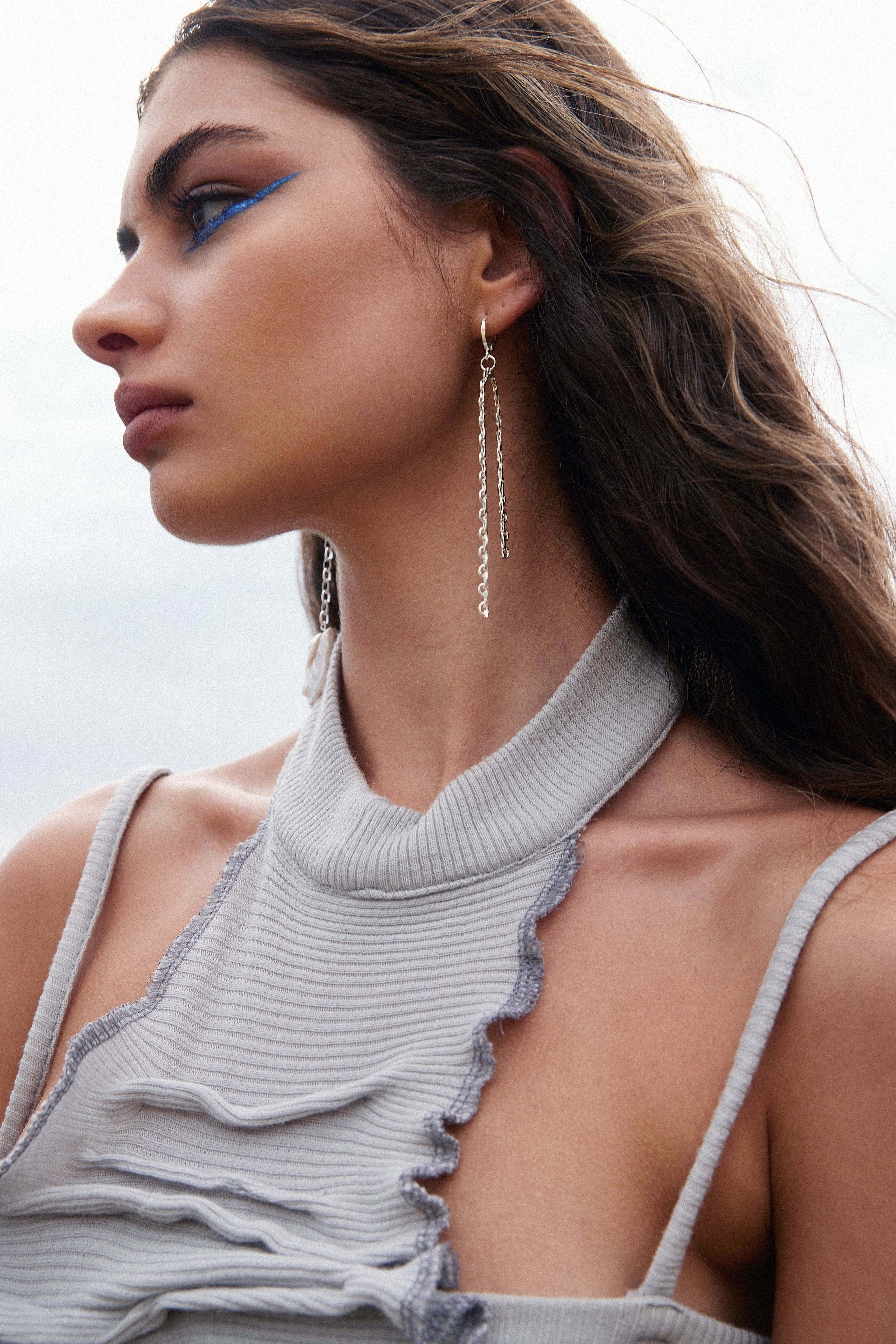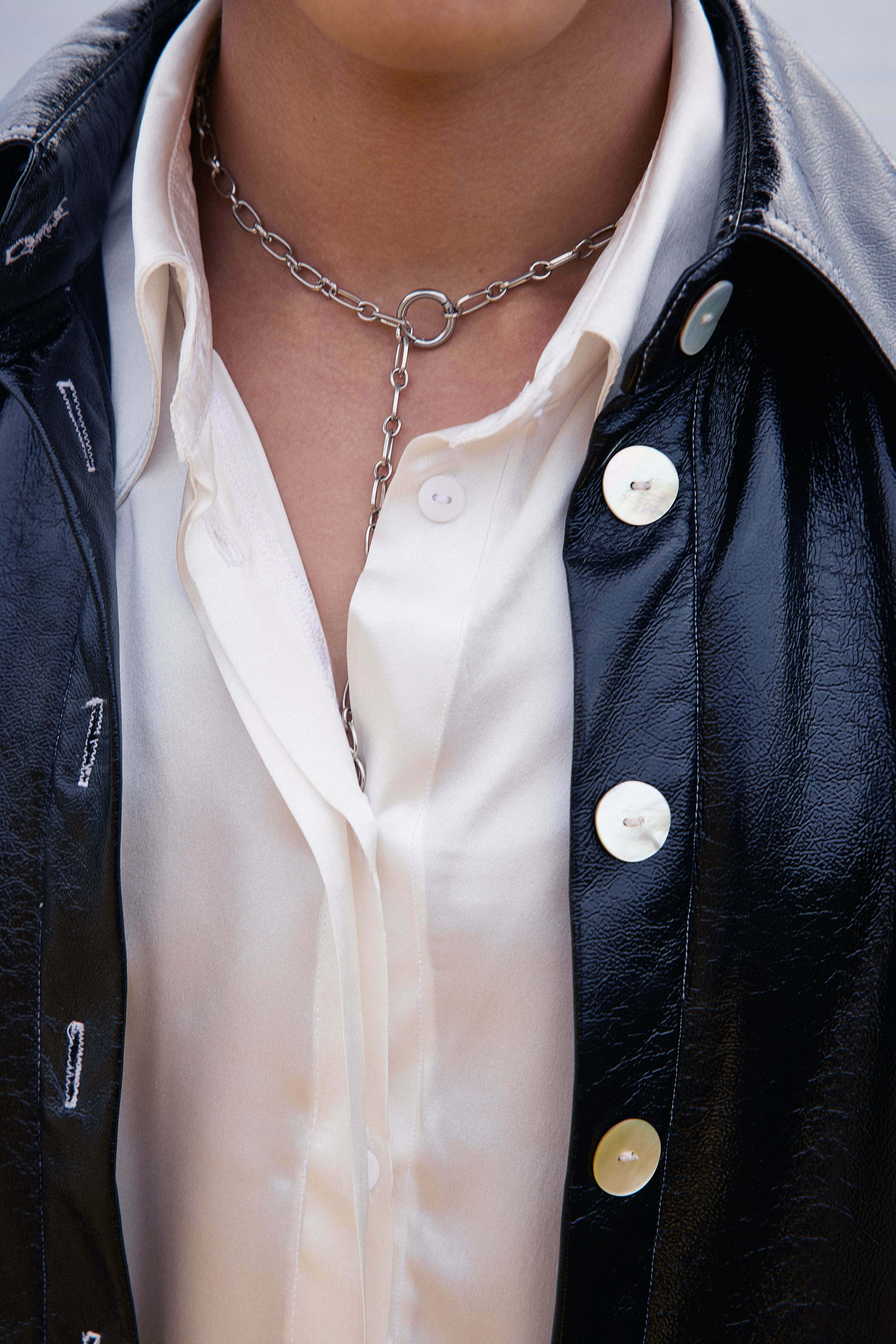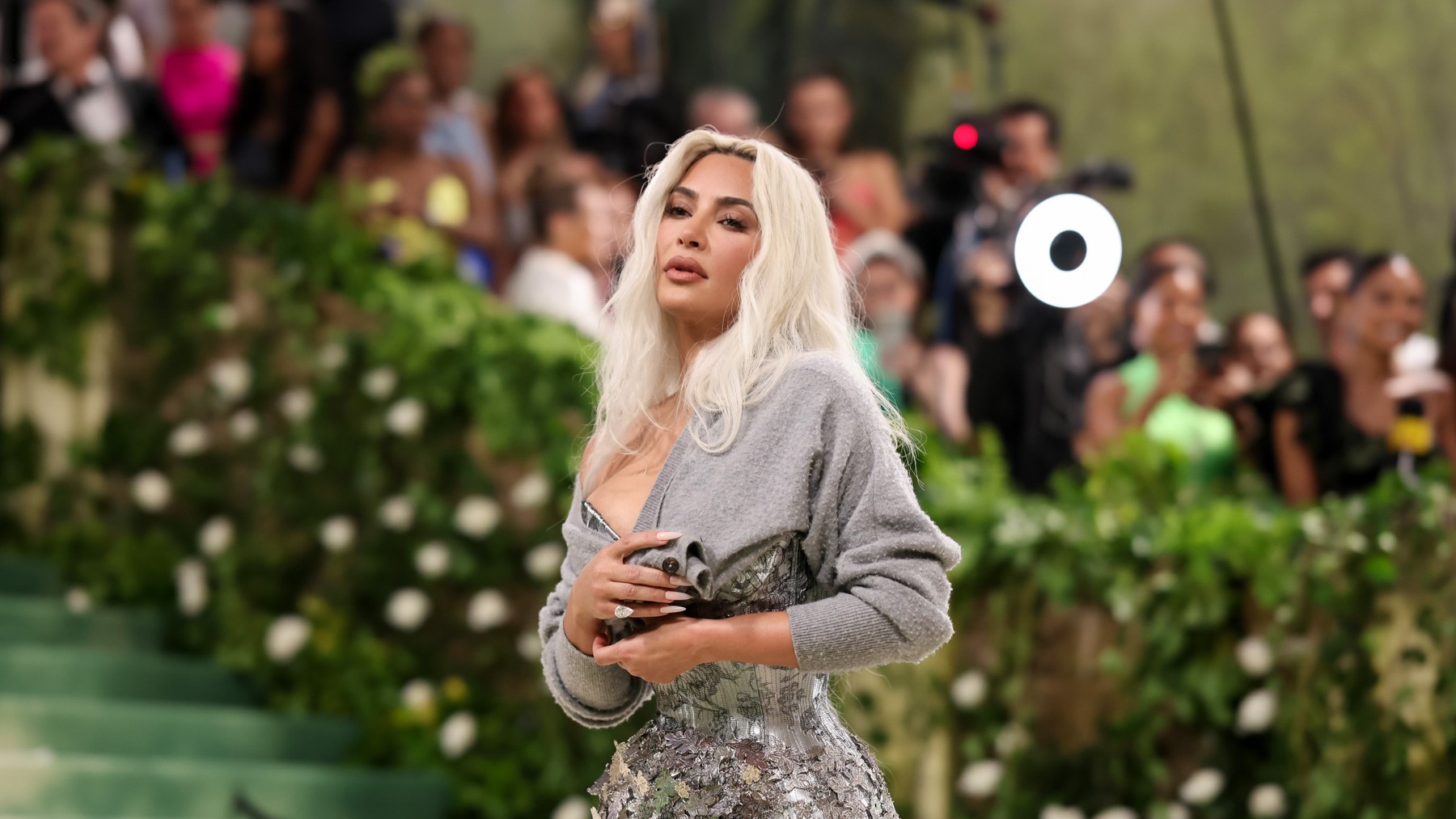Melbourne-based designer Bel Sorrentino, who launched her fashion label Sorrentino Studios in December of 2020, makes consciously crafted, handmade pieces that hint at statement-making silhouettes with a mix of multifunctional designs and delicate sewing. Each of the brand’s garments are created to be styled in several ways, whether that be detachable pieces, layering, or reversible sides.
In March, Sorrentino Studios debuted its ELEMENTS 2.0 collection, pulling inspiration from the element of water through the utilization of fluidity and gender-neutral garments. Comprised of tops, skirts, trousers, sleeves, and jewelry among other pieces, Sorrentino places design front and center with cut-outs, ruffles, and an alluring color palette that spans across ivory, cobalt blue, and grey. The Changing Tide 3-piece pant features a peplum belt with suspenders and button-on pant legs which allows for versatility, while the Two Oceans Denim Jeans carry both a low-waisted and high-waisted shape for the ultimate fit.
Elsewhere, the Multi-Way Top is a 3-in-1 style that can be worn in multiple ways, pairing with the label’s knit pants. Jewelry offerings include the Freshwater Pearl Chain necklace and earrings, crafting using a pearl nugget and lightweight silver chain. The Chain Curve Drop earring boasts a curve shape and circular closure, while the Vortex Chain ear cuff takes on a helix clip-on design. Meanwhile, the Bow Wave Knit Balaclava and water-resistant Glacier Puffer Bag—available in laptop, mini, and tote sizes—serve as the perfect accessories to round this collection out.
“There are ideas that permeate each collection—I design all my pieces to be trans-seasonal, eye-catching, and versatile—so they can be worn and styled in a variety of ways,” Bel shares. “ELEMENT 2.0, based on water, is all about fluidity and the liquid nature of gender identity. ELEMENT 3.0 and 4.0 will be focused on fire and air, so you can expect pieces that reflect passion and boldness, and movement and flight.”
To learn more about the label, we spoke with founder Bel Sorrentino to discuss the overall aesthetic of her brand, ELEMENT 2.0 collection, fluidity within her designs, and more. Check out our interview with Sorrentino Studios below.


To begin with, when did you realize you wanted to pursue a career in fashion design?
Design has always been in my blood—just ask my mum! She used to say that she’d come home and find me, armed with scissors, “making my clothes better”… by cutting them up and piecing them back together. Design was always really important to me, even as a young kid, and both my grandmothers had a huge influence on that. My mum is Chinese and my dad is Italian, and their mothers taught me almost everything about cutting, sewing, designing, fabric, patterns, and more.
My Po Po, Chinese grandmother, in particular, was extremely tactile and very resourceful, we’d sew all the time together. We didn’t speak the same language, but we communicated with our hands, gestures, and the visual language of design. She lived in China until the early 2000s and used to make, mend and alter all her own clothes to preserve their life almost indefinitely when she lived there. This resourcefulness always resonated with me, and the idea of repurposing existing garments and fixing rather than replacing has made me the designer I am today and had a profound impact on the way I view sustainability in the realm of fashion design.
How would you describe the overall aesthetic of your designs, or does it typically vary from collection to collection?
My current collection, ELEMENT 2.0, is androgynous, trans-seasonal, and bold. The main idea of each collection is rooted in its corresponding element. For example, ELEMENT 1.0 was based on earth and garments were neutral colours inspired by rocks, minerals, and landscapes, but they were also designed to anchor your wardrobe, and act as a base—just like the earth. ELEMENT 2.0, based on water, is all about fluidity and the liquid nature of gender identity. ELEMENT 3.0 and 4.0 will be focused on fire and air, so you can expect pieces that reflect passion and boldness, and movement and flight.
There are ideas that permeate each collection—I design all my pieces to be trans-seasonal, eye-catching, and versatile—so they can be worn and styled in a variety of ways. I like the idea of playful versatility, so the wearer can really have fun with the item and wear it to either anything from the office to a formal event.
The first year of any new business is a learning experience. What were some key learnings and takeaways you learned throughout the process? Is there anything you would have done differently now that you’ve made it past the one-year anniversary?
Trust yourself, trust the process and be patient. You can encourage growth, and foster it, but you cannot force it—you have to be patient, and creating a solid business foundation takes time. Believe in the values, and set them from the ground up, as they will guide future products, ideas, operations, and basically everything you do
Don’t be afraid to give it a go! Things like interviews, pop-up markets, and studio tours seemed so daunting at first—so did the basic stuff like Facebook and Google Ads! But if you never try you’ll never know, so you have to roll up your sleeves, leave your anxieties at the door, and just give it a crack.


What was the biggest highlight of creating the “Element 2.0” collection? How was it different from working on your previous releases from a design standpoint?
Creating a collection that was truly gender-fluid! I designed this collection with one of my closest friends, Ryan, in mind —and he actually modeled the collection for the lookbook. I have absolutely loved designing an androgynous collection, and look forward to doing so for every collection from here on out.
This collection is inspired by water with an emphasis on fluidity and gender-neutral garments—can you expand on some of the key elements or inspirations that you kept in mind for this collection?
I wanted pieces to be fluid in transformation and styling adaptability. This is great for the environment because one piece of clothing can be worn across multiple occasions by simply changing the way it sits on the body or detaching pieces.
For instance, our Bow Wave Top can be rotated around the body to create three different styles, so it’s as though you’re buying 3 tops in one. Another example is our Changing Tides 3-piece Pant which can be worn as a pant, tailored short, or as a peplum “skort’ by unbuttoning and detaching pieces.
Our Two Oceans reversible vest, which can be worn across all genders, is reversible and can be worn as a wrap-around vest or with the suspenders tucked into pockets. Our Rain Jacket that can also be worn as a jacket or wrap shirt. Our silk shirt can also be worn off the shoulder.
How does your affinity for materials and unconventional fabrics play a role in your design process?
It’s liberating! Sometimes I see design as just a puzzle to be solved, and playing with new materials, particularly deadstock fabrics that can be incredibly unique, really allows me to creatively problem-solve my imagined design into reality. Sometimes it doesn’t work, but I always enjoy it—and it’s all a learning process, something that doesn’t work for one thing might end up popping up years later in another design.
Beyond that how does sustainability continue to be a core element of the brand?
It’s the main thing the brand is built on – it’s a key driver in every decision I make, from choosing carbon-neutral delivery partners to Australian-made sustainable labels, it’s the main influence for all decisions. It can actually make life easier because the decision is ultimately whatever is the most environmentally conscious—the brand’s values will always steer it.


In a sense, has living in Australia or more specifically Melbourne, influenced you creatively or changed how you approach fashion? There’s been an increasing push for not only sustainable fabrics but pushing the conventional in regards to style in recent years.
I’m lucky to live in such a creative city! There are so many great designers that live here, and it’s really a place that fosters emerging designers. Pop-up markets, exhibitions, runways, and more, seem to happen so regularly, and there is such a strong appetite for sustainable design.
Shifting the conversation a bit, how have online retailers like Ethical Made Easy and Sucker played a role in growing your brand?
The number one reason, and I’m sure many smaller brands will agree, is exposure. Being visible to a wider audience that is also your exact target market is invaluable, and I’ve been able to tee up many opportunities through these retailers. It’s also great practice for working with stockists, which is something you won’t learn in a fashion course!
What advice would you give to young designers looking to break into the fashion industry?
Back your design! There is so, so much noise when you’re designing and it can be hard to know who to listen to and what to take on board, but just always remember that fashion is extremely subjective. One person’s “this isn’t for me” is another person’s “I must have this”, so roll with the punches! I’d also say you need to separate yourself from your work to an extent. I don’t mean that you should care less, you just need to be able to hear things like “this wouldn’t suit me” and not take it personally. As I said, fashion is so subjective, and you’ll go insane if you try to please everyone or fit everyone’s aesthetic. Besides, who would want that?


Published by Malcolm Trapp








